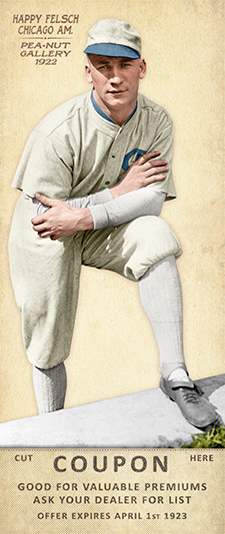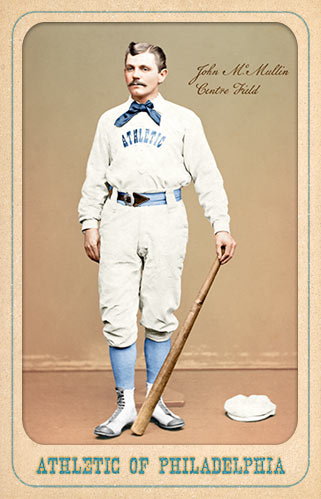
- Series: Diamond Heads '15
- City: Chicago
- Team: Cubs
- League: National League
Frank M. Schulte (1882-1949) played for his local minor league franchise, the New York State League’s Syracuse Stars, for three years before being discovered by the National League’s Chicago club, who bought his contract and brought him up at the end of the 1904 season. The team was being called the “Cubs” by sportswriters, a name that wouldn’t be official until 1907. By any name, “Wildfire” Schulte made a big impact. He was a solid-hitting outfielder who became a mainstay in West Side Park's outfield as the Cubs won four pennants and two World Series during his long tenure. Frank must have really liked the play “Wildfire” he once saw in Mississippi: He named his racehorse after the play and would earn the sobriquet for himself by teammates who clearly appreciated his spirit.
Schulte’s above average hitting (career 115 OPS+) was reliable, but he proved particularly clutch in the post-season, where he averaged .321 across 21 World Series' contests. Such fortuitous timing would further Schulte's legacy in yet another remarkable achievement: his spectacular campaign of 1911 just-so-happened to coincide with the inaugural presentation of the Chalmers Award; essentially MLB's very first MVP award, which was gifted to the "most important and useful player to the club and to the league." The prior season, Hugh Chalmers decided to spark car sales for his automotive company by offering a new model to the players with the highest batting averages in each league. The ensuing fiasco involving Ty Cobb and Nap Lajoie prompted Chalmers to revise the award in 1911 to be gifted to the leagues' “MVPs” and Schulte's career year-for-the-ages couldn't have been better timed.
Schulte’s 1911 MVP Award season:
- 154 games, 105 runs, 173 hits, 30 doubles, 21 triples, league-leading 21 HR, 107 RBI, 23 stolen bases, league-leading .534 slugging, league-leading OPS+ 156, league-leading 308 total bases
- With the performance, Schulte became the first person in MLB history to have 20 or more doubles, triples, home runs and stolen bases in the same season
- Schulte's achievement would stand unmatched for 46 years, until Willie Mays duplicated the feat in 1957
- Schulte earned his nickname by a ferocious approach to base running that saw him steal home 22 times
- Famed shortstop Joe Tinker’s Chicago career spanned Wildfire’s and Schulte inspired Tinker to speculate that no “quainter or more original character ever existed in the National Pastime.” One eccentricity was Schulte’s penchant for scouring the sidewalks looking for hairpins, auguring success at the plate.
- Another testimony to Frank’s batting prowess was his thirteen-game hit streak during his four World Series appearances, which still ranks him fourth all-time, tied with Harry Hooper and Derek Jeter
- Schulte closed out his time in Chicago with the 1916 season. He spent the next three years with three teams and went on to play in the International League and Pacific Coast League through 1922 before retiring to live in Oakland, CA
For a brief but wonderful account of the history of the Chalmers Award, including a review of the events of 1910 surrounding the controversy between Ty Cobb & Nap Lajoie, check out this Ars Longa guest blog post by Van Nightingale: Did They Get it Right?
- This card is not included in the 100-card Diamond Heads '15 base set.
- This card is one of the rewards you receive for completing the Ars Longa Clubhouse Challenge: Chalmers Awards Winners
- This card is exclusive to that challenge, is gifted freely to winners of the challenge, and is neither bartered nor sold otherwise by Ars Longa.
- This is one of two such Diamond Heads '15 Clubhouse Challenge reward cards. The other is Franklin Pierce Adams.
- Series: 1919 Black Sox Scandal
- City: Chicago
- Team: White Sox
- League: American League
Joseph Jefferson Wofford Jackson (1887-1951) had the “perfectest” swing according to Babe Ruth who copied it. After nearly a century of more contenders, many would still say Shoeless Joe was the purest hitter ever to wield a baseball bat. Expelled from baseball by Judge Landis, Jackson lives in infamy despite demonstrating prowess at the plate and grace afield. While he will ever be branded with the “Black Sox,” Jackson stirred passions that still echo in baseball today.
- Still ranks as the third-highest career batting average in history (.356)
- His .408 average in 1911, his rookie season, is sixth-highest in the modern era

- Series: 1919 Black Sox Scandal
- City: Chicago
- Team: White Sox
- League: American League
Oscar Emil Felsch (1891-1964) was a sunny-tempered soul, the epitome of the hail-fellow-well-met. Born into the German community of Milwaukee, Felsch excelled at baseball and went on to become the star center fielder for the Chicago White Sox for six seasons spanning the most tumultuous era in franchise and baseball history. Charles Comiskey brought Hap to the Windy City in 1915 as part of one of the most successful rebuilding efforts in the game’s history. Felsch joined future Hall of Famer Eddie Collins and the incomparable “Shoeless” Joe Jackson, forming a club that would become a dominant force in the American League through the WWI years. Indeed, he forged the kind of career that Jim Nitz of SABR states might have been remembered “as one of the best all-around center fielders in baseball history.” He led his hard-hitting team in home runs and slugging, he was a league-leader in both offensive and defensive stats. And everybody loved Hap.
Years after the sordid story of the Black Sox had waned, Felsch, amiable as ever, was virtually the sole source for writer Eliot Asinof’s Eight Men Out. Hap was as humble as he was forthright in recounting his role in the scandal that shook baseball and ushered in the Judge Landis autocracy that forever changed the structure of the game. “I shoulda knew better,” moaned the aged and infirm former slugger. Earlier he had testified to foreknowledge and acquiescence to the gamblers’ schemes, but always denied actively trying to lose a game, much less the Series.
Despite his reputation for a very sociable demeanor, Felsch suffered under the indignities inflicted by miserly Comiskey. Injuries, his brother’s war wounds, his father’s illness, all took a toll as well in 1919, as did the clubhouse friction between players riven by the war effort. Felsch, Jackson and others had taken defense-industry jobs in ‘18 while others had enlisted. Rivalries erupted and friendships were damaged. Into the tensions stepped unctuous underworld minions of east coast mobsters. The resulting scandal enmeshed Felsch and he never pretended innocence.
- After being ousted from organized ball by Landis, Felsch endured years of litigation mingled with varying efforts to play ball. Eventually he went north and enjoyed success in Canadian circuits while always maintaining the love and support of his hometown

- Series: Athletic of Philadelphia: 1874
- City: Philadelphia
- Team: Athletics (NAPBBP)
- League: National Association (NAPBBP)
John F. McMullin (1849-1881) began amateur ball with his hometown Keystones of Philadelphia in 1867 as an outfielder. He moved to the Buckeye of Cincinnati in ‘68 and the Haymakers of Troy in ‘70, with whom he joined the first openly professional league in 1871. He pitched for Troy his first season when the only other southpaw hurler in the NABBP was Charlie Pabor of the Union of Morrisania (who is more renowned for his nickname, The Old Woman in the Red Cap, than for his mound prowess). McMullin also pitched some for the National Association's Troy entry in ‘71, and is the only known lefty to pitch regularly that year. He served as an emergency pitcher in two games across the 1872 and ‘73 campaigns, but played primarily in the outfield the rest of his career. He always had respectable years at the plate, including his final season with the Philadelphia White Stockings in 1875 where he hit .257. His best year had been with the Athletics in 1874, leading the team with 90 hits and a .346 average.
After being a pioneering member of baseball's first two organized leagues and playing nearly all of his teams' games in the five year history of the National Association, McMullin never played a single game in the National League that replaced it. It is not known why McMullin’s tenure in baseball ended so abruptly on the eve of the modern major leagues and he would die a few short years later at age 32 in his native Philadelphia.
- In 1877, McMullin appeared as one of three managers of a Philadelphia entry in the League Alliance, a loose consortium of teams in the Northeast that formed as a response to the new NL
- Like teammate Mike McGeary, McMullen [sic] appears on an 1871 Burr Pennfield Troy Haymaker Scorecard. Inspired by and rarer than the Mort Rogers' Scorecards, such "photographic picture cards" were important precursors to the modern baseball card


- Series: Athletic of Philadelphia: 1874
- City: Philadelphia
- Team: Athletics (NAPBBP)
- League: National Association (NAPBBP)
This cabinet is currently on the drawing board and is coming soon.
Alfred W. Gedney (1849-1922) was an outfielder for four teams over four years in the National Association of Professional Base Ball Players (NAPBBP). Gedney's tenure in the first openly professional baseball league began in 1872 with the Troy Haymakers, one of the most significant of the early clubs. The "Count" then moved down to Brooklyn’s Eckfords and then over to the New York Mutuals before joining the Philadelphia Athletics in 1874. Gedney then returned to the Mutuals for a final stint in ‘75, where it appears his professional baseball career ended with the demise of the NAPBBP and the establishment of the National League in 1876. Why Gedney did not join with his many NAPBBP compatriots and transition into the new professional league is unknown, but his below average production over his years in the NAPBBP might have been a factor.
- We may only presume that Gedney’s royal nickname derived from his debonair style and elegant handlebar mustache. Early photos depict a confident man of regal bearing, clearly to the manor born.
- In 1872 with Troy, the Count actually placed second in the league in home runs with three. Lip Pike of Lord Baltimore led the league with seven.
- Gedney’s year as an Athletic of Philadelphia was actually his best. He hit .275 and tied for 2nd on the club in RBI with 34. Cap Anson led the team with 37 and Dick McBride was the other at 34.
- For his career, the Count batted .251. He managed only two more home runs following his debut with the Haymakers, and was one of only three Athletics to homer in '74
- The Brooklyn native’s first experience in amateur ball came with the Union of Morrisania (Bronx) team in the old NABBP in 1870
- Was the 137th player to debut in MLB





